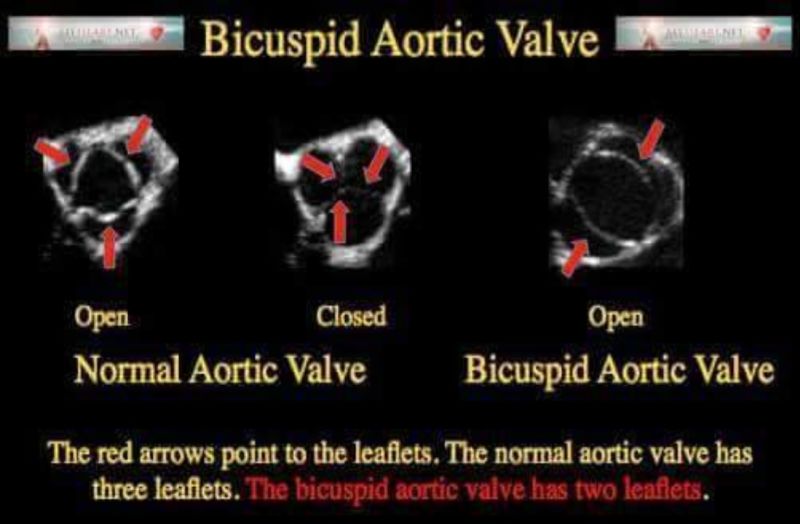Congenital Aortic Stenosis and Bicuspid Aortic Valve
Heart defects are more prevalent in children than childhood cancer - Lexi Behrndt

image by: NURSEupdate
HWN Suggests
Congenital Aortic Stenosis
A bicuspid aortic valve is the most common congenital anomaly to which that structure is subject and is the most common gross morphologic congenital abnormality of the heart or great arteries in adults...
The physiologic response of the neonate to severe aortic stenosis is best understood in light of the fetal circulation. Intrauterine left ventricular volume is low because pulmonary blood flow is virtually nil. When lungs expand at birth, pulmonary blood flow commences and a severely obstructed, thick-walled left ventricle with reduced cavity size suddenly receives a sizable increment in volume. Left ventricular filling pressure rises steeply, left atrial pressure rises in parallel,…
Resources
Aortic Stenosis - All You Must Know About It!
However, in severe aortic stenosis, treatment needs to be done In valvular aortic stenosis, treatment of choice is by doing ballooning of aortic valve (Balloon aortic valvuloplasty, BAV) in any age group.
Bicuspid Aortic Valve and Congenital Aortic Stenosis in Children
Bicuspid aortic valve (BAV) and congenital aortic stenosis are two types of heart defects that may be present at birth. They can occur separately or together. In some cases, bicuspid aortic valve causes another condition called aortic valve stenosis.
Congenital Aortic Valve Stenosis
The neonatal and well-baby check-ups perform poorly as screening tests for severe VAS. The majority of infants with severe VAS present with progressive congestive heart failure by 2 months of age. They appear pale, mottled, hypotensive and dyspneic.
Epidemiology of aortic valve stenosis (AS) and of aortic valve incompetence (AI): is the prevalence of AS/AI similar in different parts of the world?
There are large differences in the epidemiology of aortic valve disease between high-income and low-income countries.
Paediatric Aortic Stenosis
Mild aortic stenosis can be completely asymptomatic, discovered as an incidental murmur during a routine examination. More significant aortic stenosis can present with symptoms of fatigue, shortness of breath, dizziness and fainting. Symptoms are typically worse on exertion as the outflow from the left ventricle cannot keep up with demand. Severe aortic stenosis will present with heart failure within months of birth.
 Congenital Aortic Stenosis
Congenital Aortic Stenosis
The bicuspid aortic valve was first identified in the early 16th century by Leonardo da Vinci in his remarkable Anatomical, Physiological, and Embryological Drawings, released by Dover Publications in a facsimile edition.
International Society of Ultrasound in Obstetrics and Gynecology
In cases of aortic stenosis, the valve leaflets are thickened or become less pliable and fuse together. Most commonly, the abnormality occurs when the aortic valve has two instead of three leaflets (bicuspid aortic valve).
SecondsCount
Critical aortic stenosis is the extreme narrowing of the aortic valve in newborns. Before birth, a baby can survive well with only one well functioning ventricle. That is not the case after birth. With critical aortic stenosis, the left ventricle is not able to pump blood adequately through the narrowed aortic valve and into the body. As a result, a child born with this defect will become very ill soon after birth and may not survive without immediate treatment. This usually involves starting a prostaglandin E1 infusion to keep a blood vessel that normally closes after birth called the ductus arteriosus open to allow blood to get to the body. An interventional catheterization procedure called a balloon aortic valvuloplasty may need to be performed shortly after birth. In this procedure a specifically sized balloon is inflated within the valve to stretch the valve open.

Introducing Stitches!
Your Path to Meaningful Connections in the World of Health and Medicine
Connect, Collaborate, and Engage!
Coming Soon - Stitches, the innovative chat app from the creators of HWN. Join meaningful conversations on health and medical topics. Share text, images, and videos seamlessly. Connect directly within HWN's topic pages and articles.













